A Perfect Likeness
Holbein's ability to achieve almost photographic realism in
his painting made his reputation as a portrait painter, and has given posterity
an invaluable record of the members of the Tudor court.
Holbein's reputation is based on the brilliantly observed
portraits which he painted in England during the reign of Henry VIII. Their
realism is astonishing even today, and it is easy to understand the reaction of
Holbein's friend, the great scholar Erasmus, when he received the artist's
drawing of Sir Thomas More and his family: 'It is so completely successful,
that I should scarcely be able to see you better if I were with you'.
Yet Holbein did not start his career as a portrait painter.
He trained in his father's workshop in Augsburg and that of Hans Herbster in
Basel, where he not only learnt the techniques of oil painting, but also those
of book illustration and the decorative arts. Holbein's early paintings were
mainly monumental and religious works, stylistically in the Northern tradition
of Darer and Grunewald. By the late 1520s, a new influence can be seen. In The
Meyer Madonna (1526), the Northern emphasis on sharply observed realism and
incisive line is evident, but the classical motifs, calm symmetry and use of
sfumato to soften the Madonna's features show a debt to Italian Renaissance art
particularly that of Leonardo.
Many of Holbein's early religious works were probably lost
during the violent iconoclasm (destruction of holy images) of the Reformation.
This movement also put paid to a major source of potential income church
commissions which is why Holbein was forced to leave Basel in search of work in
England.
MORE AND HIS CIRCLE
 Holbein already had quite a reputation for portraiture in England,
since his portrait of Erasmus had been presented to Archbishop Warham. And most
of his first visit to England (1526-1528) was spent mainly in the production of
portraits of More and his circle most of whom knew Erasmus. These are among the
most astonishing likenesses in the history of art, and would certainly have
astounded their Tudor sitters who had never seen anything like them before. Sir
Thomas More is perfect in both its draughtsmanship and its apparent solidity in
Holbein's art, line defines form. More's face has been scrutinized and
reproduced with an almost photographic accuracy even down to the silver-tinged
stubble on his chin. And Holbein's vision is so penetrating that his realism is
not only skin deep: the slightly tensed brow above the tranquil eyes reveals
More's thoughtful character.
Holbein already had quite a reputation for portraiture in England,
since his portrait of Erasmus had been presented to Archbishop Warham. And most
of his first visit to England (1526-1528) was spent mainly in the production of
portraits of More and his circle most of whom knew Erasmus. These are among the
most astonishing likenesses in the history of art, and would certainly have
astounded their Tudor sitters who had never seen anything like them before. Sir
Thomas More is perfect in both its draughtsmanship and its apparent solidity in
Holbein's art, line defines form. More's face has been scrutinized and
reproduced with an almost photographic accuracy even down to the silver-tinged
stubble on his chin. And Holbein's vision is so penetrating that his realism is
not only skin deep: the slightly tensed brow above the tranquil eyes reveals
More's thoughtful character.
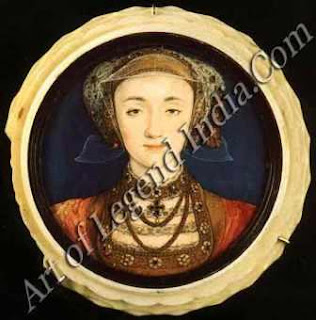
Holbein's painting depended upon his phenomenal drawing
ability. And it seems that, for him, drawing could be an end in itself, not
merely a preliminary to painting. At first, his drawings were executed in
chalks, which were sometimes heightened with water-colour. But after his return
to England in 1532, the delicacy of this technique was replaced by the more
vigorous and emphatic medium of ink. The collections of drawings at Windsor are
among Holbein's most popular works.
Part of Holbein's assured mastery of line was his ability to
capture a likeness very quickly. It is known, for example, that he was only
granted a sitting of three hours for his portrait of the Duchess of Milan. This
was enough for him to make a 'very perfect likeness'. During his first English
visit, he was not inundated by commissions, and could presumably take longer,
but once he entered royal service, such swiftness of execution would have been
necessary to supply increased demand.
A MECHANICAL AID
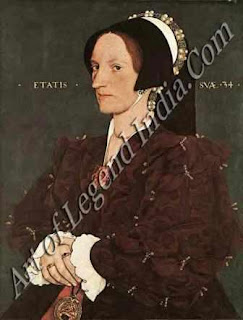 It has been suggested that Holbein may have made use of some
sort of mechanical aid to allow him to record the outline of the sitter's face
as fast as possible. Again, this would presumably only have been necessary
during his second visit to England. If he did use a mechanical aid, it may have
been a kind of tracing apparatus, of the type other artists such as Darer and
Leonardo are known to have used. This consisted of a peep-hole and a pane of
glass. The artist looked through the peep-hole and glass directly at the sitter
rather in the way that the sights of a rifle are used to ensure a perfect line
of vision and traced the outline of the sitters' features on to the glass with
an oil crayon. The outlines would then be transferred on to paper.
It has been suggested that Holbein may have made use of some
sort of mechanical aid to allow him to record the outline of the sitter's face
as fast as possible. Again, this would presumably only have been necessary
during his second visit to England. If he did use a mechanical aid, it may have
been a kind of tracing apparatus, of the type other artists such as Darer and
Leonardo are known to have used. This consisted of a peep-hole and a pane of
glass. The artist looked through the peep-hole and glass directly at the sitter
rather in the way that the sights of a rifle are used to ensure a perfect line
of vision and traced the outline of the sitters' features on to the glass with
an oil crayon. The outlines would then be transferred on to paper.
The paintings themselves were executed on wooden panels, to
which Holbein would transfer his drawings using a grey wash. He then worked up
the painted surface with meticulous accuracy, often using notes on colour and
jewellery details to help him attain a perfect reproduction of what he had
originally observed.
In the first years of Holbein's second visit to England,
when he was still hoping to attract royal favour, he often made a point of
showing off his ability to record stunning likenesses not only of faces, but
also of surface textures. In his portrait of the German merchant George Gisze
the lush folds of pink velvet are set against the woven intricacies of the
Turkish rug with an almost tangible realism. And as if to hammer home the point,
Holbein has placed a bunch of carnations in a thin glass vase which is painted
with exquisite accuracy, and through which is seen the stems of the flowers and
the woven threads of the rug.
A CHANGE IN STYLE
George Gisze is also characteristic of this particular phase
in Holbein's art in the abundance of props which surround the sitter as
attributes of his profession. About three years after this particularly
'flashy' painting, Holbein's portraits altered in a most dramatic way. The
compositions themselves became simpler, with the sitters placed against plain
backgrounds of blue or green. The lack of depth in these backdrops is often
accentuated by Latin inscriptions, placed on either side of the sitter's head,
usually indicating the date and his or her age.
The plain backgrounds serve to heighten the impact of the
portraits themselves. The flatness of composition became particularly
pronounced in many of the half-length portraits which Holbein executed of and
for Henry VIII, where it was accompanied by an increased emphasis on linear
patterning. In his portrait of Henry VIII, for example, the predominance of
line is still evident, but it is put to a more decorative purpose. The
sumptuous patterns of Henry's doublet and jewels, the flattened arms, and the
head and hat almost cut out against the blue background all combine to create
an icon-like image appropriate for a monarch who was also the Supreme Head of
the Church of England. Although the face is as individualized as that of Sir
Thomas More painted nine years previously, the effect of the painting is
entirely different. Sir Thomas More is a portrait of a man, Henry VIII is an
image of god-like majesty.
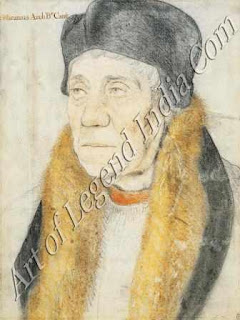 It was Holbein's ability to create such spectacles of power
that won him the chance to paint his most prestigious work, the Whitehall
fresco. For the king did not want a family portrait, he wanted an image of
absolute authority that combined physical might with symbolic legitimacy.
It was Holbein's ability to create such spectacles of power
that won him the chance to paint his most prestigious work, the Whitehall
fresco. For the king did not want a family portrait, he wanted an image of
absolute authority that combined physical might with symbolic legitimacy.
It is an irony that Holbein's consummate achievement has not
existed for nearly 300 years it was destroyed in a fire in 1698. But the
surviving copies and cartoon leave no doubt that the bloated, bulging, pig-eyed
figure of Henry VIII must have been awe-inspiring. Visitors to the palace were
said to be 'abashed' and 'annihilated' and many believed they were in the
presence of the king himself.
In his cartoon for Henry's portrait, Holbein shows him
turning slightly towards the queen, Jane Seymour; in the final painting,
however, the king confronts the spectator directly. Obviously, Holbein's
rendering of him was not designed to flatter, it was designed to glorify and
magnify. The impression of raw power and indomitable energy is created partly
by the sheer bulk of the figure, and partly by the contrast of Henry's
challenging, virile pose with the more spiritual calm of the other three
figures, whose eyes do not engage the spectator's.
ART AND PROPAGANDA
Holbein achieved these effects by using a whole range of
artistic devices, but most of all he drew on the recognizable vocabulary of
religious painting. '['he way in which the group is posed, for example, is
reminiscent of the standard Renaissance arrangement for a Madonna and child
flanked by saints. Holbein translated the language of religion into that of
politics, and for the Holy Family he substituted the royal family. In this way
he was able to create an image which simultaneously demonstrated the political
supremacy of the Tudor dynasty, and the supremacy of Henry himself as head of
the Church in England. In the process, Holbein had combined art and propaganda.
Writer – Marshall
Cavendish
 Holbein already had quite a reputation for portraiture in England,
since his portrait of Erasmus had been presented to Archbishop Warham. And most
of his first visit to England (1526-1528) was spent mainly in the production of
portraits of More and his circle most of whom knew Erasmus. These are among the
most astonishing likenesses in the history of art, and would certainly have
astounded their Tudor sitters who had never seen anything like them before. Sir
Thomas More is perfect in both its draughtsmanship and its apparent solidity in
Holbein's art, line defines form. More's face has been scrutinized and
reproduced with an almost photographic accuracy even down to the silver-tinged
stubble on his chin. And Holbein's vision is so penetrating that his realism is
not only skin deep: the slightly tensed brow above the tranquil eyes reveals
More's thoughtful character.
Holbein already had quite a reputation for portraiture in England,
since his portrait of Erasmus had been presented to Archbishop Warham. And most
of his first visit to England (1526-1528) was spent mainly in the production of
portraits of More and his circle most of whom knew Erasmus. These are among the
most astonishing likenesses in the history of art, and would certainly have
astounded their Tudor sitters who had never seen anything like them before. Sir
Thomas More is perfect in both its draughtsmanship and its apparent solidity in
Holbein's art, line defines form. More's face has been scrutinized and
reproduced with an almost photographic accuracy even down to the silver-tinged
stubble on his chin. And Holbein's vision is so penetrating that his realism is
not only skin deep: the slightly tensed brow above the tranquil eyes reveals
More's thoughtful character.  It has been suggested that Holbein may have made use of some
sort of mechanical aid to allow him to record the outline of the sitter's face
as fast as possible. Again, this would presumably only have been necessary
during his second visit to England. If he did use a mechanical aid, it may have
been a kind of tracing apparatus, of the type other artists such as Darer and
Leonardo are known to have used. This consisted of a peep-hole and a pane of
glass. The artist looked through the peep-hole and glass directly at the sitter
rather in the way that the sights of a rifle are used to ensure a perfect line
of vision and traced the outline of the sitters' features on to the glass with
an oil crayon. The outlines would then be transferred on to paper.
It has been suggested that Holbein may have made use of some
sort of mechanical aid to allow him to record the outline of the sitter's face
as fast as possible. Again, this would presumably only have been necessary
during his second visit to England. If he did use a mechanical aid, it may have
been a kind of tracing apparatus, of the type other artists such as Darer and
Leonardo are known to have used. This consisted of a peep-hole and a pane of
glass. The artist looked through the peep-hole and glass directly at the sitter
rather in the way that the sights of a rifle are used to ensure a perfect line
of vision and traced the outline of the sitters' features on to the glass with
an oil crayon. The outlines would then be transferred on to paper.  It was Holbein's ability to create such spectacles of power
that won him the chance to paint his most prestigious work, the Whitehall
fresco. For the king did not want a family portrait, he wanted an image of
absolute authority that combined physical might with symbolic legitimacy.
It was Holbein's ability to create such spectacles of power
that won him the chance to paint his most prestigious work, the Whitehall
fresco. For the king did not want a family portrait, he wanted an image of
absolute authority that combined physical might with symbolic legitimacy. 
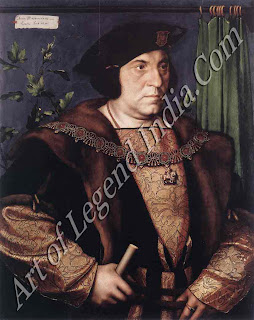


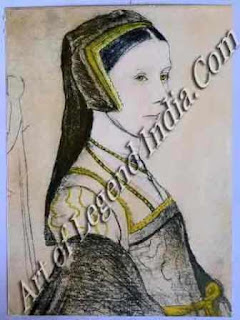










0 Response to "German Great Artist Hans Holbein - A Perfect Likeness "
Post a Comment